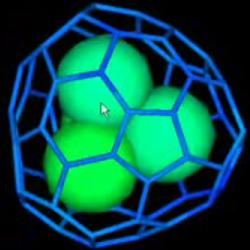Extremely thin "graphene" sheets keep everything inside

Sealed containers are not always truly sealed. As any child will discover the day after their birthday party, even a tightly tied helium balloon will leak gas after a few hours. Now, scientists have developed a highly effective barrier that does not allow any leakage.
As described in the latest issue of the scientific journal Applied Physics Letters, this encapsulation material consists of graphene, a natural carbon tissue with a thickness of a single atomic layer.
A related form of carbon, graphite, is used in pencil leads. At the microscopic level, graphite contains millions of two-dimensional surfaces of carbon atoms. The fact that these surfaces are very loosely bound together is what makes graphite a good lubricant. Graphene is the structure obtained if one of the surfaces of the graphite is taken at a time. These small fragments of carbon - like a hexagonal network made up of carbon atoms - are barely visible and therefore graphene was only discovered a few years ago.
Now, thanks to the interesting properties of graphene - such as the fact that electrons can move in it with almost no loss of energy - it has become a "hot" topic among physicists and chemists. One of its most impressive features is its mechanical strength, which is surprising in its size in light of its great thinness.
Both laboratory experiments and computer simulations have shown that graphene sheets are able to withstand high pressures and serve as perfect molecular containers. Theoretical physicists in the group of Francois Peeters from the University of Belgium conducted experiments with the aim of examining how graphene sheets are able to store gases in a tiny balloon-like structure. If there is a single atom that can escape from this nanoscopic bag - it will be helium. As one of the noble gases, helium is chemically inert and may pass through any framework of atomic thickness.
In an experiment at Cornell University in Harold Craighead's lab, a sheet of graphene stretched around a tiny vial did show that the gas, even at high pressures, remained inside. (This work was published in the scientific journal Nano Letters).
The researcher points out that graphene, apart from its electronic properties, can contribute to a number of nanotechnological products. Examples of this include tiny pressure sensors: a sheet of graphene around a bottle containing gas at a certain pressure will vibrate at a frequency corresponding to the internal pressure of the gas. A tiny patch of graphene could be used as a nanoresonator (a device in which electrical, mechanical or acoustic resonance is created, Resonator): after being clamped on both sides, the graphene will vibrate at radio frequencies. It will be possible to transmit an electrical signal to it, so that the graphene can be used as a tiny radio antenna. It will be possible to use graphene even as an artificial membrane - in its design as a nanoscopic bubble, like an artificial cell, the graphene will be able to contain a drug that will be released into the body at controlled time points.

4 תגובות
How can a grid of hexagons be sealed? After all, any particle that can pass through the mesh will leak out.
I would appreciate it if the names were brought in English as well
Just one - just a comment...
Good Morning…
I say this with cosmic hope, that in a few years we will be able to develop (and survive)
And we will have more and more, until the time comes for us to have flexible and strong materials like in the descriptions of the spaceships (UFOs) that exist in the world...
I so hope that in a few years my logic will look at these materials and fully understand why and how they exist...
Every step of the way is welcome 🙂